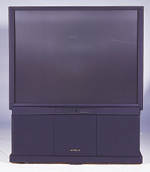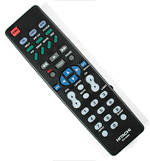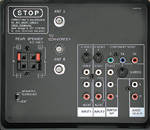Face Off: Big-Screen Smackdown Hitachi 50GX20B
Having won our DTV Face Off last November, Hitachi was eager to jump in the ring for this month's analog roundup. We rolled the 50GX20B into our evaluation room and couldn't help but notice some striking similarities (at least, from the backside) between it and the Zenith IQB50M92W that was coincidentally placed right next to it. The similarities end there, however. Like so many wrestling characters, this set has some particular features that will make you either love it or hate it.
 To begin with, connections aren't abundant, but they'll do fine in most systems. You get two audio/video inputs, both with composite or y/c (S-video) connectors. The second input adds the higher-quality component connector for your DVD player. Send audio to your hi-fi system via the variable audio output and route audio and video to your VCR through the fixed monitor output. The latter even has a y/c connection. Additional inputs include speaker terminals that utilize a built-in amplifier to power better front or surround speakers at the flip of a switch. This is a good audio-upgrade path. As it turned out, the other panelists found the absence of a front-panel input the most fatal flaw, thus tipping the scale toward the Mitsubishi or Panasonic display in terms of features.
To begin with, connections aren't abundant, but they'll do fine in most systems. You get two audio/video inputs, both with composite or y/c (S-video) connectors. The second input adds the higher-quality component connector for your DVD player. Send audio to your hi-fi system via the variable audio output and route audio and video to your VCR through the fixed monitor output. The latter even has a y/c connection. Additional inputs include speaker terminals that utilize a built-in amplifier to power better front or surround speakers at the flip of a switch. This is a good audio-upgrade path. As it turned out, the other panelists found the absence of a front-panel input the most fatal flaw, thus tipping the scale toward the Mitsubishi or Panasonic display in terms of features.
While connections are adequate, the user interface is a mixed bag. Hitachi's remote offers preprogrammed control of the TV, a VCR, and a cable box, and it backlights major functions. Chris even found the controller's larger menu buttons advantageous. Clint and I, on the other hand, felt both the ergonomics and aesthetics were unsatisfying.
 Unfortunately for Hitachi, their onscreen graphics aren't much different than the ones on their DTV display. None of the panelists liked them then, and none of us like them now. Granted, the layout and functions make setting up the display relatively easy, but the menu covers 90 percent of the image, which makes adjusting the picture controls cumbersome, at best.
Unfortunately for Hitachi, their onscreen graphics aren't much different than the ones on their DTV display. None of the panelists liked them then, and none of us like them now. Granted, the layout and functions make setting up the display relatively easy, but the menu covers 90 percent of the image, which makes adjusting the picture controls cumbersome, at best.
Picture quality, however, is what really matters, and this is one area that Hitachi has taken to an extreme. For one, they've used a fairly inexpensive comb filter. Chris mentioned that it allows a fair amount of dot crawl (zipperlike artifacts between vertical color borders), while Clint noticed some cross-color artifacts (rainbows that appear in fine detail)—more so than on the other displays. Then again, the 50GX20B's color decoder can be made fairly accurate in the user adjustments, allowing for better color saturation and a more-vibrant picture. The set's DC restoration, which causes black levels to drift slightly as the image gets darker or brighter, is more stable than the DC restoration on the other TVs in the Face Off.
 Probably the biggest impact on the picture, though, was the gray scale. Hitachi offers two different gray-scale (aka color-temperature) settings: a punchy, bluish cool and a more-accurate warm. Even in the warm mode, the Hitachi's image looks blue. Clint, for one, didn't like the washed-out, almost purple look on people's faces. Nearly all the panelists ranked this set at the bottom of their performance lists. Then again, our own research shows that average viewers prefer a bluer, less-accurate picture. As with the DC restoration, the image can be corrected by an ISF technician (for a few hundred bucks) to look more accurate. With our set "professionally" adjusted, the picture was nearly identical to that of the Zenith display—which was ranked highest in the Face Off—offering what Chris described as a more-natural picture with warmer-looking fleshtones.
Probably the biggest impact on the picture, though, was the gray scale. Hitachi offers two different gray-scale (aka color-temperature) settings: a punchy, bluish cool and a more-accurate warm. Even in the warm mode, the Hitachi's image looks blue. Clint, for one, didn't like the washed-out, almost purple look on people's faces. Nearly all the panelists ranked this set at the bottom of their performance lists. Then again, our own research shows that average viewers prefer a bluer, less-accurate picture. As with the DC restoration, the image can be corrected by an ISF technician (for a few hundred bucks) to look more accurate. With our set "professionally" adjusted, the picture was nearly identical to that of the Zenith display—which was ranked highest in the Face Off—offering what Chris described as a more-natural picture with warmer-looking fleshtones.
For those people who watch TV with the room lights on and like a brighter, punchier, cooler picture, the Hitachi set may be perfect. Enthusiasts, like us, might look for a set with more inputs, a better comb filter, and more-accurate factory adjustments. Keep in mind that we'd recommend calibrating any TV, regardless of how it comes from the factory, and this TV, when calibrated, can look excellent.
• Backlit remote
• Better black level than other contestants

HT Labs Measures: Hitachi 50GX20B
The chart above shows the gray scale (or color temperature) of the Hitachi TV and the color points of the display's red, green, and blue phosphors. The gray scale measures noticeably blue (10,000 Kelvin), even in the more-accurate warm setting. After making adjustments using the Photo Research SR-650, the gray scale tracks between 6,000 and 6,500 K across the entire range. Only with extremely dark images does the gray scale lean toward red at 4,880 K. The Hitachi's phosphor colors are close to those specified by SMPTE. Properly calibrated, it should be able to reproduce the entire color spectrum. The light output was approximately 37 foot-lamberts, which is plenty for most rooms. The display has average DC restoration and an accurate color decoder.—MW

- Log in or register to post comments




































































